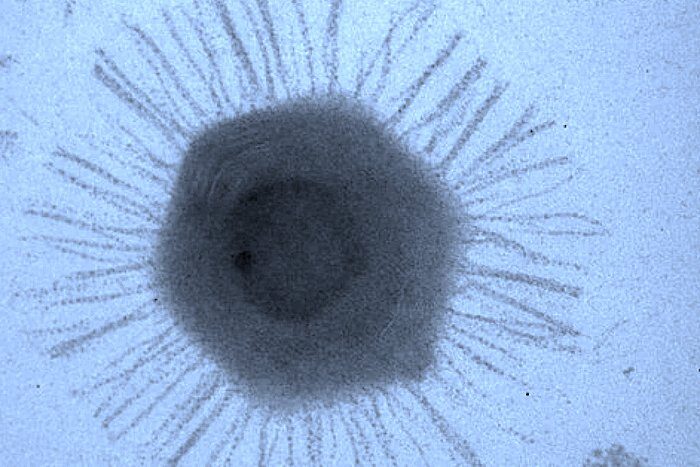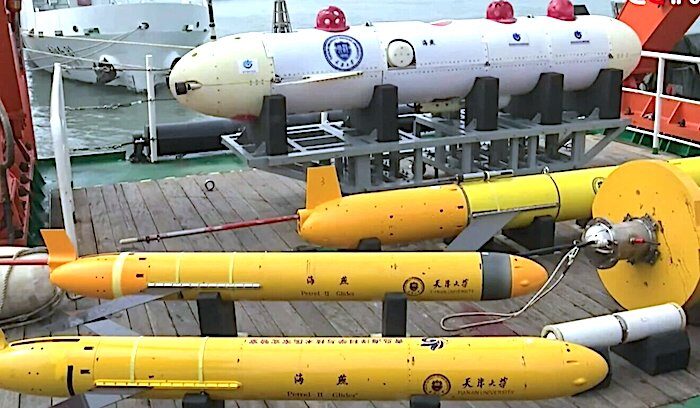The many legends of giant sea creatures have been largely debunked because of the challenges to large, complex life forms at the greatest ocean depths.
But the researchers discovered several giant viral species, including mimiviruses - which typically use amoeba as their hosts - in sediments taken from a seabed nearly 11,000 metres (36,000 feet) below sea level at Challenger Deep.
And, while giant viruses have been found elsewhere, they appeared to be more abundant at the extreme depth, where pressure is 1,100 times that of the atmosphere, than in other conditions, where they are usually rare.
Previous attempts to obtain viral samples from Challenger Deep failed because of the extreme technical challenges but samples collected five years ago by the advanced research ship Zhang Jian yielded enough material for the team to obtain genome sequences of 15 different types of viruses and more than 100 kinds of other microorganisms.
The researchers also raised more than 2,000 strains of microorganisms in a high pressure laboratory environment, although they were unable to revive any of the viruses, according to a paper published this month in the journal Genome Biology.
Li Xuan, a professor with the Institute of Plant Physiology and Ecology at the Chinese Academy of Sciences, wrote:
"The full biosphere structure and functional exploration of microbial communities of the Challenger Deep of the Mariana Trench, the deepest known hadal zone on Earth, lag far behind that of other marine realms. In addition to elevated hydrostatic pressure (60-110 MPa), the trench environments are characterised as near-freezing temperatures, total darkness, poor nutrient availability, and isolation in topography."Mimiviruses - which made up more than 4 per cent of the total viral population in the sampled seabed - were initially mistaken for bacteria when scientists first saw them during a pneumonia outbreak in 1992. With their hairy fibres and bodies which can be up to 700 nanometres wide, they can sometimes be visible to the naked eye.
Li and his colleagues were not able to see the deep sea samples directly in a dish, though, because of the small number obtained. But they did gain some insights into this unusual and little-known family of viruses.
Scientists have been intrigued about the mimivirus since its identification, not only because of its unusual size, but also its exceptionally complex genome of more than 1.2 million base pairs - more than any other virus. The genomic sequence of the novel coronavirus, for example, is 40 times shorter.
In some experiments, these giant viruses were able to cause tissue damage in mammals, but so far there is no evidence they can directly harm human beings.
Viruses are one of the simplest parasitic life forms, depending on their hosts for essential activities such as protein production and metabolism. In the mimivirus, however, researchers have discovered a number of productive genes related to these activities and previously found only in more independent life forms, such as bacteria or single cell animals.
Some scientists have speculated that, like many parasites, mimiviruses went through a "reverse evolution", from microbes to viruses. But why they retained so many productive functions in their genes remained a puzzle.
Li and his collaborators from Fudan University and Shanghai Ocean University believe these seemingly useless genes might have played a crucial role in the fight for survival in the great depths. While all parasites exploit their hosts, the relationship could change in an extreme environment, they said.
Genetic analysis suggested the giant virus might use the productive genes to help its hosts - such as fungi and single-cell animals - by accelerating the breakdown of ingested carbohydrates, for instance, according to the researchers. Faster metabolism and growth could give the hosts - and their viruses - a competitive edge in the dark and quiet Challenger Deep, where nutrients are scarce and competition for them is brutal.
But, the researchers said, the host-virus relationship remained a theory, because of their inability to resurrect the viruses in the laboratory.
The Mariana Trench in the Western Pacific Ocean is more than 3,000km (1,864 miles) from Shanghai, but has played an important role in China's marine research programmes.
China's deep sea glider Haiyan, for instance has made long journeys through the trench to collect various environmental data. It picked up disturbances generated by three passing typhoons at a depth of more than 7,000 metres, according to information revealed by authorities this month.
The Chinese research has attracted opposition from the US which has its largest military base in Guam, southeast of the trench and part of Washington's "second island chain" defence line to contain China. Some Chinese vessels have been monitored by US spy planes as their research activities in the Mariana and nearby waters have increased over the past decade.
The Chinese government says scientific exploration in the deepest waters on Earth will increase human knowledge of this largely unknown world, and help future environmental protection when deep sea mining becomes necessary.
While the Covid-19 pandemic has raised concerns about the safety of collecting and studying viruses from nature, the mainstream research community still believes that our best defence strategy is to have a better understanding of unknown strains.
Genetic information about organisms living in extreme environments could also lead to the discovery of new drugs or biological tools, they say.
About the Author:
Stephen Chen investigates major research projects in China, a new power house of scientific and technological innovation. He has worked for the Post since 2006. He is an alumnus of Shantou University, the Hong Kong University of Science and Technology, and the Semester at Sea programme which he attended with a full scholarship from the Seawise Foundation.





Reader Comments